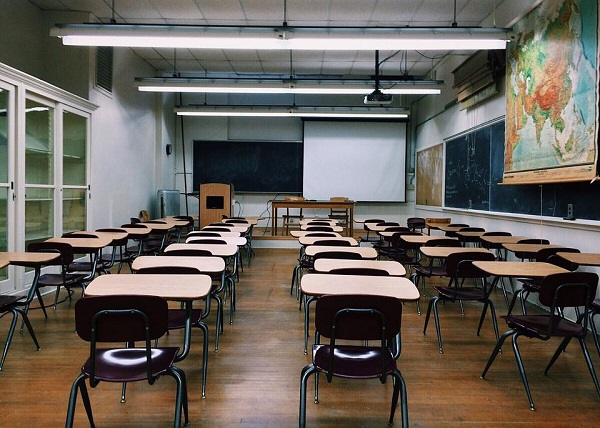Do you value local journalism? Support NottinghamMD.com today.
BALTIMORE, MD—Student proficiency rates in English Language Arts (ELA) in School Year 2022-2023 are at their highest in nearly a decade with the largest single-year gain in grades 3-8 over the same time period. Statewide results (PDF) of the latest Maryland Comprehensive Assessment Program (MCAP) assessments show notable improvements in literacy and mathematics, with literacy results surpassing pre-pandemic performance. Student proficiency rates in mathematics show signs of recovery from pandemic learning loss. Across all grades, a substantial percentage of students were on the cusp of achieving proficiency in literacy and mathematics. A lower percentage of students are scoring at the lowest performance level in literacy and mathematics. In school year 2022-2023, Maryland set its new baseline of post-pandemic proficiency – a baseline upon which the State will build from here forward with a relentless commitment to students. This new baseline offers a strong beginning, but it is just that: a beginning.
For students in grade 3, for example, the proficiency rate in literacy reached a nine-year high of 48%. The increase comes after a profound commitment to early literacy by the Maryland State Board of Education and the Maryland State Department of Education. These are not just numbers, but children; for children in grade 3, achieving and maintaining proficiency in literacy is a marker of successfully transitioning from learning to read, to reading to learn. The development and mastery of early literacy skills are a strong predictor of later school reading and math achievement.
MSBE has led the way in this work – committing and reaffirming its commitment to early literacy and early literacy interventions, like, for example, with the Ready to Read Strategic Plan priority in Maryland Transforms, the MSBE’s and MSDE’s comprehensive Strategic Plan, which decisively codifies early literacy as a paramount focus, ensuring that foundational reading skills are not just encouraged, but are systematically woven into the fabric of Maryland’s educational trajectory. This priority is not just the priority of the State Board – it reflects the priority of Marylanders.
In engaging with over 30,000 voices across Maryland, parents and guardians resoundingly prioritized one thing: they want their children to successfully read and write. This sentiment is not exclusive to parents and guardians; employers, too, have ranked early literacy as a top priority. Acting on this clear mandate, these MCAP results show significant strides – better results for all children, with improvements across every subgroup, than in a decade. And this is just the beginning – evidenced by that work being further codified as part of local education agencies’ (LEA) Initial Blueprint for Maryland’s Future Implementation Plan submission templates and approval requirements during school year 2022-2023.
“The investments in the Blueprint for Maryland’s Future, along with the emergency federal funding, are testament to the unwavering commitment that the State holds for its focus on children and their success. This is about children being able to read. As improvements are evident between the 2022 and 2023 data,” said Clarence C. Crawford, President of the Maryland State Board of Education, “we will continue to push forward in collaboration with local school systems and Boards to ensure that every Maryland student is nurtured to their full potential, thriving academically and personally. Our work has just begun.”
MSDE has made and continues to make unprecedented, targeted, and strategic investments in supporting schools and educators as they work to increase the percentage of students who are ready to read by the end of third grade. Key among these efforts has been the Maryland Leads grant initiative designed to use federal funds to address learning loss from COVID-19, bridge educational disparities, and better support underserved students. Maryland Leads emphasizes seven transformative strategies, notably adopting the Science of Reading and Structured Literacy. With these funds, LEAs train K-3 staff, adopt and implement high-quality, content-rich, and culturally responsive instructional materials, and monitor progress.
This era of progress is shared with the Maryland General Assembly, the Kirwan Commission, and the newly established Accountability and Implementation Board (AIB). These groups played pivotal roles in envisioning and steadfastly supporting the Blueprint for Maryland’s Future. Maryland’s leaders embraced education as the key to societal and economic advancement, boldly investing in strategic initiatives that empower teachers, foster early learning, and equalize opportunities for students of all backgrounds. Today’s promising MCAP results stand as a testament to their committed leadership, which is setting a course to uplift not just today’s students, but generations of Marylanders to come.
“The Maryland General Assembly recognized that the COVID-19 pandemic disruptions posed an urgent crisis to our students’ educational attainment,” said Senate President Bill Ferguson. “That’s why the legislature made historic investments in recent years to bridge the digital divide, and scale learning interventions like tutoring and summer school to get our kids back on track. The improvement of MCAP scores throughout the State demonstrates the efficacy of that strategy and the importance of sustainable Blueprint funding so every Maryland student can maximize their potential.”
The progress is not isolated; it is equitable and widespread. Data shows encouraging trends across all subgroups of students, demonstrating that MSDE’s commitment to narrow and close achievement gaps is not just a promise—it is practice. “These improvements are a testament to the unwavering dedication of our educators, families, and communities championing our students’ futures,” said State Superintendent of Schools Mohammed Choudhury. “While we celebrate this progress, we are acutely aware of the challenges that lie ahead, especially for our historically underserved students. Our post-pandemic MCAP data is a clear call to action to elevate student engagement and achievement, particularly in math and middle grades. The Blueprint and our Strategic Plan are our compasses, as we remain committed to serving every child with unyielding resolve. Our goal is unequivocal: to have all Maryland students college and career ready. We are stubborn in our accountability; unrelenting in our mission to narrow and ultimately close opportunity and achievement gaps. We set this high bar for ourselves, and we will not waver until we reach it.”
Student proficiency rates in English Language Arts (ELA) in SY 2022-2023 are at their highest in nearly a decade with the largest single-year gain in grades 3-8 over the same time period
Forty-seven percent of students were proficient in ELA in grades 3 through 8 combined in school year 2022-2023, which surpasses the 44% of students scoring proficient in school year 2018-2019, prior to the pandemic. Students in nearly all grade levels attained similar or improved proficiency rates in ELA in comparison to school year 2018-2019. The percentage of students who were proficient in ELA in grades 3 through 8 combined in school year 2022-2023 is the highest since school year 2014-2015, with an increase of almost 8 percentage points from the 39% scoring proficient in 2014-2015. The recent upward trend in ELA scores can also be seen in the English 10 assessment. Fifty-four percent of students assessed were proficient, an increase of 11 percentage points over the 43% scoring proficient in school year 2018-2019. With the school year 2022-2023 results, student proficiency in English 10 is at its highest since school year 2014-2015, the year when the Partnership for Assessment of Readiness for College and Careers (PARCC) was implemented.
Figure 1: Percent of Students Proficient in ELA 3-8 and English 10 in School Year 2022-2023
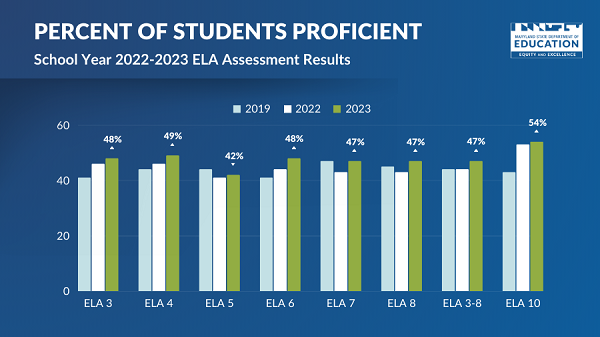
Most student groups surpassed pre-pandemic proficiency in English Language Arts (ELA), including historically underserved students
The 2022-2023 assessment results in ELA in grades 3 through 8 combined showed gains for most student groups, including historically underserved students, with proficiency rates returning to pre-pandemic levels and, in some cases, surpassing pre-pandemic levels.
Black/African American students have seen a rise in their proficiency rates in ELA in grades 3 through 8 combined, from 28% in school year 2018-2019 to 34% in school year 2022-2023. For Students with Disabilities, the percentage of students scoring proficient rose to 12% in school year 2022-2023, up four percentage points from their pre-pandemic performance.
Improvements were also notable for economically disadvantaged students, with a 7 percentage-point increase in the percentage of students scoring proficient in school year 2022-2023 as compared to the prior year. Data for identifying students as economically disadvantaged were first collected in school year 2018-2019 and reported in school year 2021-2022.
Recent gains in English Language Arts (ELA) in grade 3 bring student proficiency to a nine-year high
The percentage of students who were proficient in ELA in grade 3 reached 48% in school year 2022-2023, up from 46% in the previous year. From 2018-2019 to 2022-2023, proficiency rates in ELA in grade 3 increased by 7 percentage points.
Figure 2: Percent of Grade 3 Students Proficient in ELA in School Year 2022-2023
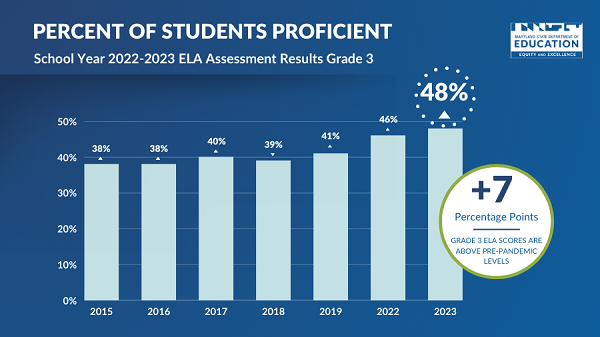
Student proficiency rates in mathematics show signs of recovery from pandemic learning loss
The percentage of students proficient in the mathematics assessments in grades 3 through 8 combined improved in school year 2022-2023 as compared to school year 2021-2022, although results have not yet returned to pre-pandemic levels. Twenty-five percent of students in grades 3 through 8 combined were proficient in mathematics in school year 2022-2023, which surpasses the 22% of students scoring proficient in school year 2021-2022. Gains were larger for economically disadvantaged students, with a 4 percentage-point increase in their proficiency rates in mathematics in grades 3 through 8 combined year over year.
Students across grades 3 through 8 showed increases in mathematics proficiency in school year 2022-2023 as compared to school year 2021-2022. The largest gains were seen for students in grades 3 and 4, with a 4 percentage-point increase in each case. In the Algebra I assessment, 17% of students were proficient, an increase of 3 percentage points over the 14% of students scoring proficient in school year 2021-2022.
In the face of persistent challenges, this year’s MCAP data illuminates a hopeful trend: the targeted math interventions implemented by Maryland’s educational leaders are beginning to take root, as evidenced by increased proficiency rates across multiple grade levels, showcasing the resilience and potential of Maryland’s students. MSDE is actively working to support LEAs and educators in reversing Covid-19 pandemic learning loss in mathematics, improving student achievement in mathematics across the board, and narrowing opportunity gaps. Recently, Maryland joined the National Partnership for Student Success and will launch the Maryland Tutoring Corps. Through this innovative grant program, MSDE will invest up to $10 million to establish a permanent tutoring corps aimed at supporting students who are not proficient in mathematics. Priority will be given to middle school students in grades 6 to 8, Algebra students of any grade level, and historically underserved students including Black/African American students, economically disadvantaged students, English learners, and students with disabilities who are not proficient in mathematics.
MSDE is also investing in strengthening mathematics instruction under the Blueprint for Maryland’s Future. The Blueprint requires LEAs to identify high-quality, content-rich, and culturally responsive instructional materials for all grade levels in mathematics. LEAs must have an inclusive and rigorous process in place for selecting high-quality instructional materials (HQIM). LEAs are also required to explain how cultural responsiveness is assessed when reviewing instructional materials as well as plans for supplementing materials to ensure that they meet the cultural needs of students. LEAs must develop a detailed plan for providing ongoing professional development and instructional support to educators to ensure implementation of HQIM with fidelity.
Professional learning for educators is a central component of the State’s efforts to improve student proficiency in mathematics across all grade spans. In school year 2023-2024, MSDE will partner with LEAs to host learning labs that highlight best practices in elementary mathematics instruction. These learning labs are designed to ensure mathematics educators across the State gain a thorough understanding of the systematic vision and planning needed to improve student outcomes in mathematics. Mathematics leaders who complete the labs will be prepared to return to their LEA and recreate the systems, structures, and processes that promote effective mathematics instruction. Leaders will be ready to cultivate a school culture that prioritizes time and space for teachers to plan and implement effective instructional practices through data analysis, reflection, and collaboration as it relates to elementary mathematics.
During school year 2023-2024, MSDE will also offer a high-leverage professional learning series focused on enhancing instructional practices that improve student confidence and consistency with modeling and reasoning in mathematics. Student proficiency in these areas is essential to achieve procedural and conceptual mastery in mathematics skills, and to prepare students for the college or career pathway of their choice. However, students across the State demonstrate persistent challenges with comprehension and mastery of modeling and reasoning with mathematics. The professional learning series will address this challenge by providing opportunities for mathematics classroom teachers and school-based mathematics coaches to explore and implement evidence-based instructional practices and tasks that support modeling and reasoning with mathematics.
Across all grades, a substantial percentage of students were on the cusp of achieving proficiency in English Language Arts (ELA) and mathematics
Between 16 and 22% of students in ELA, and between 11 and 17% of students in mathematics were on the cusp of proficiency, defined as a score range of 740-749, or less than ten points below the threshold for proficiency. These students were, on average, only one to three additional correct answers from achieving proficiency. Providing on-time and targeted supports to students on the cusp of proficiency will contribute to improving student performance in ELA and mathematics across all grade levels.
Figure 3: Percentage of Students On the Cusp of Proficiency in ELA and Mathematics in School Year 2022-2023
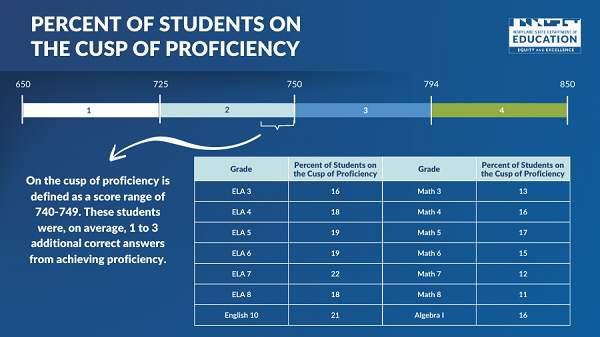
A lower percentage of students are scoring at the lowest performance level in English Language Arts (ELA) and mathematics
The distribution of student scores among the four MCAP performance levels shows a reduction in the percentage of students who scored at the lowest performance level in ELA in grades 3 through 8 combined as well as in English 10. For ELA 3-8, the percentage of students who scored at the lowest performance level decreased from 13% in school year 2021-2022 to 11% in school year 2022-2023. In English 10, the percentage was 6% in school year 2022-2023, a decrease of 2 percentage points from school year 2021-2022.
The distribution of student scores for mathematics reveals an even larger drop in the percentage of students at the lowest performance level. In school year 2022-2023, a third of the students assessed in mathematics in grades 3 through 8 combined scored at the lowest performance level, down from 36% in school year 2021-2022. In Algebra I, there was a 5 percentage-point drop in the percentage of students scoring at the lowest performance level, falling from 37% in school year 2021-2022 to 32% in school year 2022-2023.
Figure 4: Percentage of Students at the Lowest Performance Level in Mathematics in School Year 2022-2023
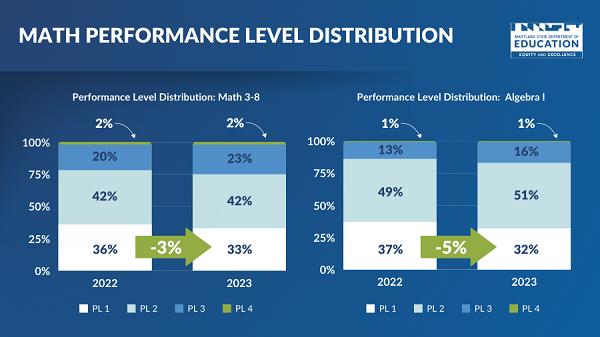
Grade 5 science scores have exceeded pre-pandemic levels; a call to action to improve grade 8 results
The percentage of students in grade 5 that met grade-level science proficiency increased nearly four percentage points, from 31% in school year 2021-2022 to 35% in school year 2022-2023. This year’s statewide science results show progress and continued academic recovery in grade 5 among Maryland public school students, who experienced multiple years of pandemic-induced disruptions to learning.
Notable gains were seen for most student groups in grade 5. Proficiency increased nearly six percentage points for economically disadvantaged students, and encouraging gains were seen for students with disabilities, with proficiency increasing from 8% in school year 2021-2022 to 11% in school year 2022-2023.
Figure 5: Percent of Grade 5 Students Proficient in Science in School Year 2022-2023
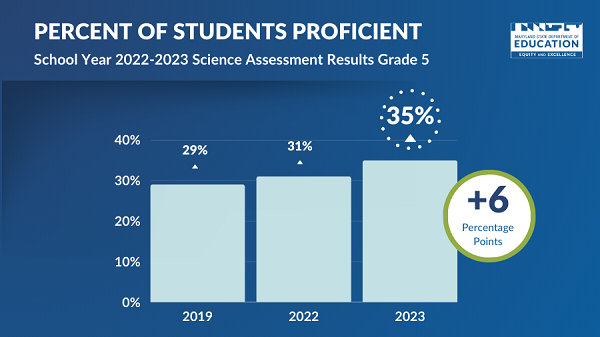
The 2023 MCAP science assessment saw fewer grade 8 students proficient than in school year 2022-2023, with 26% of grade 8 students reaching proficiency as compared to 35% in the prior year. Declines in proficiency as compared to school year 2021-2022 were seen across student groups. Grade 8 students in school year 2022-2023 were in grade 6 during school year 2020-2021, a year of predominantly virtual education in Maryland. The results on the grade 8 assessment make clear the impact of grade 6 and 7 disruptions on a cumulative grade 8 assessment. Additionally, these students did not participate in the grade 5 science assessment due to the waiver from the U.S. Department of Education from assessments administered in spring 2020 due to COVID-19.
The MCAP grade 5 and 8 science assessments are designed to measure student proficiency on the Next Generation Science Standards (NGSS). As a lead partner in the implementation of the NGSS standards, Maryland was an early adopter of the NGSS in 2013 and the new science standards were fully implemented by school year 2017-2018. Currently, Maryland is one of five states, including Washington, D.C., that have passed federal peer review on their science assessment implementation[1].
In contrast to previous standards that emphasized one aspect of science at a time, the new NGSS science standards are three-dimensional and integrate disciplinary core ideas, science and engineering practices, and crosscutting concepts into performance expectations that require students to make sense of real-world phenomena and solve authentic problems. Crosscutting concepts help students explore connections across Physical Science, Life Science, Earth and Space Science, and Engineering Design.
Science and Engineering Practices describe the behaviors of scientists as they investigate and build models and theories about the natural world, as well as the practices of engineers when they design and build models and systems. Disciplinary core ideas aim to focus K-12 science curriculum, instruction, and assessments on the most important aspects of science.
About the Maryland Comprehensive Assessment Program (MCAP) Assessments
The Every Student Succeeds Act (ESSA) requires that states administer annual assessments to all students in ELA and mathematics in grades 3-8 and once in high school. ESSA also requires a statewide assessment in science for each grade band – grades 3-5, grades 6-8, and once in high school. Additional ESSA requirements include annual English language proficiency assessments in grades K-12 for all English learners and alternate assessments for students with significant cognitive disabilities.
The Partnership for Assessment of Readiness for College and Careers (PARCC) test was administered from 2015 to 2019. No assessment was administered in 2020 due to the COVID-19 pandemic. The 2021 assessment was a modified assessment that was administered in the fall of the 2021-2022 school year.
The MCAP assessments measure mastery of Maryland content standards to ensure that all students are progressing and receiving the necessary supports for remediation and enrichment. MCAP assessments include four student performance levels: Beginning Learner, Developing Learner, Proficient Learner, and Distinguished Learner. Both distinguished and proficient learners are considered proficient.
The school year 2022-2023 administration of the MCAP assessments is now complete. All students have received or will receive an Individual Student Report (ISR). This report allows educators and families to better understand a student’s performance on Maryland content standards individually and as compared to peers in their school, county or city, and the State. Additional detailed information is also provided on how a student performed on sub-scores such as content, modeling and reasoning for math, and an indication of the level of support or enrichment that may be needed. ISRs provide students and families with information about students’ scores and performance levels to identify strengths and areas of improvement.
The school year 2022-2023 assessment results, including disaggregation of data by LEA and student groups, will be presented at the August 22, 2023, Maryland State Board of Education meeting. State, LEA, and school level data will be published on the Maryland Report Card website in September 26, 2023.
Photo via Pixabay

